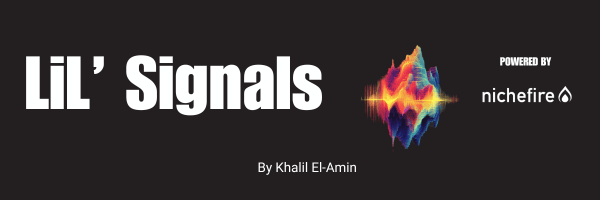- Lil' Signals
- Posts
- Lil’ Signals: The Blowout Test
Lil’ Signals: The Blowout Test
Inside the parenting rituals that reveal how people actually choose products—and why brands need to listen

👋🏽 Hey There
Lil’ Signals is your go-to newsletter for decoding the cultural currents shaping our world. Powered by Nichefire’s cutting-edge technology, we break down trends, tell compelling stories, and share actionable insights on how to tap into the power of cultural listening.
Stay ahead of the curve—one signal at a time.
In this edition, we’re swapping focus groups for Facebook mom groups and showing how the most overlooked insights often live in the messiest moments.
At Nichefire, we believe culture doesn’t just happen on runways and red carpets; it shows up in living rooms, Reddit threads, and even in the middle of toddler meltdowns. That’s why this week’s Storytime takes you inside the true chaos of raising twin toddlers and what it taught us about how real people make product decisions.
From duct-taped diapers to unexpected brand loyalty, we explore why the best insights often come from those closest to the behavior. Because when you’re building for parents, creators, or consumers, lived experience is not optional; it’s essential.
And in this week’s Cultural Listening 101, we’ll show you how to translate cultural moments, like coffee rituals and Bravo fandoms, into content ideas that hit with speed, relevance, and clarity. Think creative sprints, not content slogs.
If you want to get closer to culture, get closer to the people who live it.
Let’s dive in 🎯
Table of Contents

StoryTime
Storytime: The Diaper Dilemma
What Twin Toddlers Taught Me About Culture and Product Choice

Parenting five kids, including twin toddlers, turns your home into a live experiment.
A place where human behavior, chaos, and creativity all meet before 9 a.m.
A few months ago, my wife and I were dealing with a new challenge.
Our twin girls, not even two yet, discovered how to take off their diapers during naps.
One figured it out. The other followed.
What started as cute quickly turned into full-blown diaper anarchy.
Clothes everywhere. Sheets soaked. Pee puddles. And on a few unforgettable days, worse.
We tried everything.
Sleep routines, reversed pajamas, even zip-up onesies with the zippers tucked in.
Nothing stuck. Finally, in a moment of parental desperation, we turned to duct tape.
Yes, we taped their diapers on. And it worked.
At first, my wife felt unsure.
Was this too extreme? Too weird? But when she brought it up in a Facebook group of other twin moms, the responses were immediate.
“We do that too.” “Total lifesaver.” “Don’t feel bad. Just do what works.”
That moment said everything. What felt unconventional suddenly felt valid. Because someone else had been there too.
This is the power of culture. It helps us know what’s okay, what’s normal, and what’s possible, especially in unfamiliar moments.
Not long after, I found myself in a meeting with a research team working on a project around diaper trends.
They came prepared.
They had data, hypotheses, and a clear direction.
However, as the conversation progressed, I noticed something missing: not expertise, but proximity.
They asked whether parents choose diapers based on ingredients.
It was a smart question, especially in today’s clean-label market.
But in the real world of parenting, that’s usually not where the journey starts.
I explained how it typically goes:
“You use what’s gifted at your baby shower. You rotate through brands, trying to make sense of what holds up and what doesn’t. A blowout on the car seat? That brand is done. A rash after two days? Time to switch. Eventually, through chaos and elimination, you land on a product you trust. Not because of the label, but because it kept your day from falling apart.”
This wasn’t a critique. It was an invitation.
If you’re building insights teams, make sure you’re pulling in voices with lived experience.
Whether it’s a parent on your team, a caregiver in your community, or a niche group online, culture becomes visible when you get close to it.
Experience doesn’t replace data; it gives it depth.
That’s how my wife ended up writing a note to Huggies, suggesting a diaper that fastens in the back.
Not as a joke, but as a real product idea that could help thousands of parents avoid the same nightmare.
Because duct tape shouldn’t be part of anyone’s morning routine.
The lesson is simple. The best insights come when you combine data, creativity, and real life. Culture lives in those in-between spaces.
Let’s keep listening.
Stay curious. Stay connected. Stay ahead.
Let’s decode what’s next. Together.
Let’s explore the power of culture, one signal at a time.

Cultural Listening 101
Cultural Listening 101: How to Turn Cultural Signals Into Content Ideas
If you’ve ever stared at a blank content calendar wondering what to post, this one’s for you.
In this week’s lesson, we’re walking through a real workflow on how to turn cultural signals like “morning coffee rituals” into actual content ideas that connect. It’s not about guessing. It’s about listening, identifying what matters, and building from there.
Here’s how we do it.
Step 1: Start With the Trend Signal
We began with a broader cultural theme: Work-from-home rituals. From there, we zoomed in on a specific sub-trend that stood out: Caffeinated Confessions.
Why this one?
Because it intersects with the growing “homegrown health” movement, where people are opting out of traditional sources like doctors and leaning into community forums, wearable tech, and influencers to shape their wellness routines. Coffee, it turns out, plays a big role in that.
Takeaway: Choose trend signals that connect to real emotional behaviors, not just hashtags. Look for intersections of health, habits, and identity, which are powerful layers.
Step 2: Look for the “Why” Behind the Behavior
Once we locked in on “Caffeinated Confessions,” we explored the cultural drivers behind it. Reddit was key here. People weren’t just talking about coffee—they were storytelling. Confessions like “I need coffee before I can make coffee” weren’t just funny; they revealed how caffeine is embedded in people’s sense of rhythm, productivity, and even survival.
Takeaway: Don’t just observe the trend. Ask what it says about how people feel, act, and connect. That’s where the insight lives.
Step 3: Use Tools to Spark Creative Ideas
To build on what we learned, I used GPT to generate content prompts based on the Reddit discussions. This helped surface creative ideas like:
• Pod and Pour ASMR: No dialogue, just the calming sounds of coffee being made.
• Pod Pairing Playlists: Curated music to match your coffee energy.
• Fandom tie-ins: Coffee memes using quotes or scenes from pop culture shows.
Takeaway: Use AI tools to move fast, but start with cultural context. GPT is powerful when it builds off real community conversations.
Step 4: Map It to Your Brand or Product
In this example, we asked: What would content look like for a brand like Donut Shop by Keurig Dr. Pepper? That’s where the insights came to life. The same approach works across any vertical, just swap the brand and align the tone.
Takeaway: Always ground creative ideas in the voice, vibe, and values of the brand. Culture gives you the doorway. Your brand walks through it.
Step 5: Repeat Across Other Communities
We used the same playbook to explore Bravo TV fandoms. Real Housewives spin-offs became a source for memes, reaction clips, and quotes that could easily feed into social content. If the culture is loud in a community, it’s likely loud in the algorithm too.
Takeaway: Explore multiple communities. Coffee lovers and Bravo fans may have different languages, but the same rules apply: listen, find the emotion, and build content around it.
Final Thought
This workflow took less than an hour to complete. No massive research deck. No long approvals. Just listening, ideating, and aligning. That’s the power of cultural listening. You don’t need more noise. You need the right signal.
Let culture lead. Your content will follow.
Want help replicating this inside your own category?
Reach out for a walkthrough and start making cultural listening work for you.
See you next week for another installment of Cultural Listening 101.
Thank you for subscribing to Lil’ Signals. If you enjoyed this post or know someone who may find it useful, please share it with them and encourage them to subscribe:

Content Engines
I want to see what you can create!
Got a cool AI-generated video?
Creative Experiment?
A bold Idea?
Share it with me!
Reply to this email with your best creations, and let’s see who’s leading the AI content revolution. 📤✨

Top Cultural Trends
Stay Ahead with Nichefire
In this new section, we’re diving into Nichefire’s unique tools to explore the top cultural trends shaping our world.
This week, we break down key insights from the Movements Matrix, spotlighting high-growth and emerging trends across 47 cultural categories
Spot Emerging Trends: Discover niche opportunities before they hit the mainstream.
Actionable Insights: Leverage cultural data to make faster, smarter decisions.
Comprehensive View: Analyze trends across 47 pre-trained cultural categories.
Lil’ Surfing 🌊
Just interesting articles I find on “The Internets” 😜

💬 Your journey into the world of cultural insights starts here!
Thank you for being part of the Lil’ Signals community. Together, we’ll decode the world, one signal at a time.
Reply